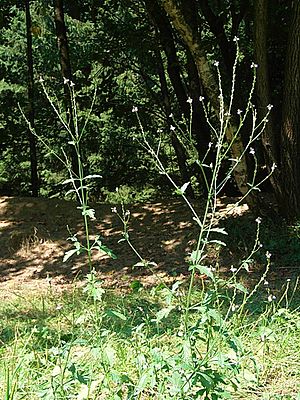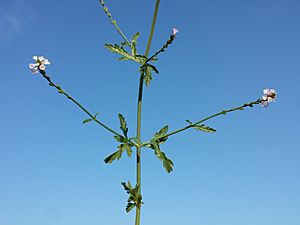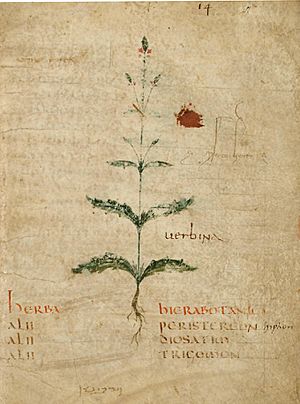Common vervain facts for kids
Quick facts for kids Common vervain |
|
|---|---|
 |
|
| Flowering | |
| Scientific classification | |
| Genus: |
Verbena
|
| Species: |
officinalis
|
| Synonyms | |
|
|
Verbena officinalis, also known as common vervain or common verbena, is a type of herb that lives for many years (a perennial). It originally comes from Europe. This plant can grow up to 70 centimeters (about 2.3 feet) tall and stands straight up. Its leaves have jagged edges, and its delicate flower spikes hold small groups of purple-pink flowers.
Common vervain likes soils that contain lime. Sometimes, people grow it as an ornamental plant because it looks nice. However, it is more often grown for its special properties that some herbalists believe it has. New plants can grow from root cuttings or seeds. It has spread and now grows naturally in many places outside Europe, like North America.
What is Common Vervain?
Common vervain has many other names! Some people call it simpler's joy or holy herb. It can also be called "mosquito plant" or "wild hyssop", but these names can sometimes refer to other plants too. The name "blue vervain" is also used, but this usually refers to a different plant called V. hastata. In many places, because it's the only plant of its kind (genus) growing there, people just call it "vervain".
In many languages in Central and Eastern Europe, the common names for V. officinalis often connect it to iron. For example:
- Echtes Eisenkraut in German means "true ironherb."
- IJzerhard in Dutch means "iron-hard."
- Læge-Jernurt in Danish means "medical ironherb."
- Železník lekársky in Slovak means "medical ironherb."
- Rohtorautayrtti in Finnish means "medical ironherb."
- Közönséges vasfű in Hungarian means "common irongrass."
The famous scientist Carl Linnaeus first described common vervain in 1753 in his book Species Plantarum. Its scientific name, Verbena officinalis, comes from old words. Verbena was an Ancient Roman word for any powerful herb used in special ceremonies. Officinalis is a Latin word that means "used in medicine or herbalism".
How Humans Use Vervain
People have valued common vervain for a very long time, even since classical antiquity (ancient Greek and Roman times). It has often been linked to gods and supernatural powers. It has also been used as a medicinal plant for a long time. For example, herbal capsules made from vervain are sometimes used to help people sleep, similar to how valerian is used.
In traditional Austrian medicine, Verbena officinalis herb was used as a tea or a drink to help with infections and fever. People usually use common vervain as a herbal tea. Nicholas Culpeper's 1652 book, The English Physitian, talks about how people used it. "Vervain" is also one of the original 38 Bach flower remedies, which are used to help with emotions like being "over-enthusiastic." Today, some people think it helps poets and writers because its relaxing effects can help with writer's block. However, it is not safe to use during pregnancy.
Even though common vervain is not originally from North America, it was brought there. The Pawnee people in North America have used it to enhance their spiritual experiences and to help with oneiromancy (dream interpretation). They sometimes call it the North American version of Calea zacatechichi.
In western Eurasia, when people say "verbena" or "vervain," they usually mean this plant because it's the most common one from its genus found there. In Ancient Egypt, it was called "tears of Isis" (a goddess). Later, in Ancient Greece, it was linked to Eos Erigineia, the goddess of dawn. In early Christian times, a folk story said that common vervain was used to stop Jesus' wounds from bleeding after he was taken from the cross. This is why it got names like "Holy Herb."
Because of its connection to the Passion of Christ, people used it in special ointments to try and get rid of "demonic" illnesses. Vervain flowers are carved onto cimaruta, which are Italian charms used to protect against bad magic. In an 1870 book about magic, it was mentioned as an ingredient for a special charm.
An old saying from 1905, quoting an even older book from 1721, goes: "Vervain and Dill / Hinder witches from their will." This shows how people believed vervain had protective powers.
Vervain's Chemistry
Scientists have studied common vervain to find out what chemicals it contains. They have found several compounds, including β-sitosterol, ursolic acid, and oleanolic acid. They also found two special compounds called iridoid glucosides: verbenalin and hastatoside. These two compounds are known to have sleep-promoting properties, meaning they can help you fall asleep. Other compounds found include verbascoside, verbenol, apigenin, and aucubin.
|
See also
 In Spanish: Verbena officinalis para niños
In Spanish: Verbena officinalis para niños



